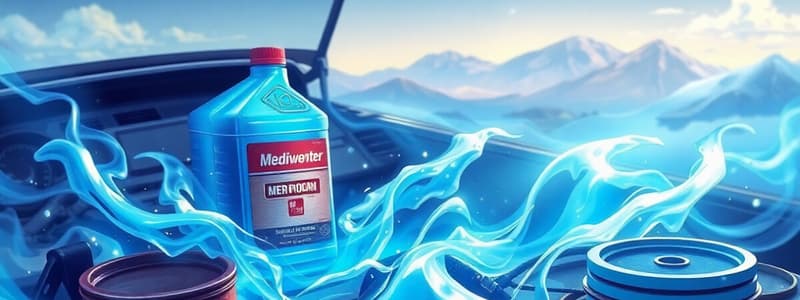Podcast
Questions and Answers
What is a key characteristic of propylene glycol-based coolants compared to ethylene glycol-based coolants?
What is a key characteristic of propylene glycol-based coolants compared to ethylene glycol-based coolants?
- It should not be mixed with ethylene glycol. (correct)
- It is more harmful to animals.
- It is used as factory-fill coolant.
- It is sweet tasting.
Which type of coolant is known for being phosphate-free?
Which type of coolant is known for being phosphate-free?
- Traditional coolant
- Hybrid organic acid technology (HOAT)
- Mineral-based coolant
- Organic acid technology (OAT) (correct)
What does the abbreviation HOAT stand for?
What does the abbreviation HOAT stand for?
- Hydroxy organic acid technology
- Hydrocarbon organic acid technology
- Hybrid organic acid technology (correct)
- High odor acid technology
Which coolant type is specifically mentioned as not compatible with both IAT and OAT coolants?
Which coolant type is specifically mentioned as not compatible with both IAT and OAT coolants?
Which property makes phosphate-free coolant more environmentally friendly?
Which property makes phosphate-free coolant more environmentally friendly?
What does the thermostat control in an automobile cooling system?
What does the thermostat control in an automobile cooling system?
Why should a person not rely solely on color to identify coolant type?
Why should a person not rely solely on color to identify coolant type?
What is the effect of coolant compatibility on vehicle maintenance?
What is the effect of coolant compatibility on vehicle maintenance?
What is the primary function of the water pump in a vehicle's cooling system?
What is the primary function of the water pump in a vehicle's cooling system?
Which component is typically driven by the crankshaft in the cooling system?
Which component is typically driven by the crankshaft in the cooling system?
What type of pump is used in vehicle cooling systems?
What type of pump is used in vehicle cooling systems?
What is the role of the radiator in an automotive cooling system?
What is the role of the radiator in an automotive cooling system?
What materials are commonly used for the tanks attached to the radiator core?
What materials are commonly used for the tanks attached to the radiator core?
What component in the cooling system may have multiple units in some vehicles?
What component in the cooling system may have multiple units in some vehicles?
How is the water pump usually mounted in a vehicle's cooling system?
How is the water pump usually mounted in a vehicle's cooling system?
Which part of the radiator is primarily responsible for exposing coolant to air for heat exchange?
Which part of the radiator is primarily responsible for exposing coolant to air for heat exchange?
What effect does lime and dirt buildup in coolant passages have on engine performance?
What effect does lime and dirt buildup in coolant passages have on engine performance?
Why is it important to inspect all cooling system hoses?
Why is it important to inspect all cooling system hoses?
How should coolant be added to an engine if the level is too low?
How should coolant be added to an engine if the level is too low?
What does a coolant hydrometer measure?
What does a coolant hydrometer measure?
What potential danger exists when opening the cap on a warm cooling system?
What potential danger exists when opening the cap on a warm cooling system?
What should be checked in the radiator during a cooling system inspection?
What should be checked in the radiator during a cooling system inspection?
How does a refractometer assess coolant condition?
How does a refractometer assess coolant condition?
What is the recommended action if the radiator shows signs of leaks?
What is the recommended action if the radiator shows signs of leaks?
What is essential for replacement radiator hoses?
What is essential for replacement radiator hoses?
What should be done first when replacing a hose?
What should be done first when replacing a hose?
What is the purpose of dipping the ends of a new hose in coolant before installation?
What is the purpose of dipping the ends of a new hose in coolant before installation?
What must be done after positioning the hose on its fittings?
What must be done after positioning the hose on its fittings?
What type of clamps can be used for thermoplastic hoses?
What type of clamps can be used for thermoplastic hoses?
When replacing a thermostat, what must always be replaced along with it?
When replacing a thermostat, what must always be replaced along with it?
What should be done to the mating surfaces of the thermostat housing and block before installation?
What should be done to the mating surfaces of the thermostat housing and block before installation?
Why is changing the engine's coolant part of preventive maintenance?
Why is changing the engine's coolant part of preventive maintenance?
What happens to the cooling fan motor when the engine coolant temperature exceeds approximately 110°C (230°F)?
What happens to the cooling fan motor when the engine coolant temperature exceeds approximately 110°C (230°F)?
What type of fan has mostly replaced conventional belt-driven fans in late model vehicles?
What type of fan has mostly replaced conventional belt-driven fans in late model vehicles?
Which feature allows the cooling fan to operate even when the vehicle is off?
Which feature allows the cooling fan to operate even when the vehicle is off?
What does the coolant temperature indicator usually consist of?
What does the coolant temperature indicator usually consist of?
Where is a block heater typically installed?
Where is a block heater typically installed?
What happens to the relay contacts when engine coolant is below 101.6°C (215°F)?
What happens to the relay contacts when engine coolant is below 101.6°C (215°F)?
What is the primary function of the electric cooling fan?
What is the primary function of the electric cooling fan?
What must be done regularly for the cooling system of a vehicle?
What must be done regularly for the cooling system of a vehicle?
Flashcards are hidden until you start studying
Study Notes
Coolants Overview
- IAT (Inorganic Additive Technology) coolant is incompatible with new long-life coolants.
- Propylene glycol-based coolants are less harmful than ethylene glycol but not suitable for factory-fill and must not be mixed with ethylene glycol.
- Phosphate-free coolants, which are ethylene glycol-based and free of phosphates, are environmentally friendly and recommended by some manufacturers.
- Organic Acid Technology (OAT) coolant is also environmentally friendly, phosphate and silicate-free, commonly recognized by the brand DEX-COOL.
- Hybrid Organic Acid Technology (HOAT) is less abrasive to water pumps, used by Ford and Chrysler, and incompatible with IAT or OAT coolants.
Engine Cooling System Components
- The thermostat regulates the engine's minimum operating temperature, while maximum temperature depends on engine output and cooling system efficiency.
- The water pump, essential for circulating coolant, is typically driven by the crankshaft via belts and may feature a centrifugal design with rotating impellers.
Radiator Functionality
- The radiator acts as a liquid-to-air heat exchanger, facilitating heat transfer from the engine coolant to the air.
- The core of the radiator is composed of tubes and fins, maximizing heat exposure to air for efficient cooling.
- Radiators typically have plastic or aluminum tanks attached for structural integrity.
Fan and Temperature Control
- Modern vehicles often have 12-volt motor-driven cooling fans that reduce power consumption and noise compared to traditional belt-driven fans.
- The engine cooling fan operates based on coolant temperature; it activates when the temperature exceeds approximately 110°C (230°F).
Coolant Warning Systems
- A coolant temperature indicator alerts drivers of overheating through gauges or lights, relying on temperature sensors in the water jacket.
- Block heaters can be installed in vehicles to prevent freezing by warming the coolant.
Cooling System Maintenance
- Inspect all cooling system hoses for leaks or damage and replace any that show wear.
- Radiators must be checked for leaks, dirt buildup, and blockages to ensure optimal performance.
- Coolant levels should be monitored at the recovery tank, maintaining levels between LOW and FULL indicators.
Coolant Quality Testing
- A coolant hydrometer measures antifreeze concentration and freezing point of the coolant.
- A refractometer provides precise coolant condition assessments by evaluating light refraction through the fluid sample.
Hose and Thermostat Replacement
- When replacing hoses, ensure correct diameter and shape, and lubricate the ends with coolant to ease installation.
- Replace thermostat gaskets to avoid leaks and ensure a clean mating surface when installing a new thermostat.
General Safety Precautions
- Always allow the cooling system to cool before opening caps to prevent pressurized hot coolant from escaping.
- Regular coolant changes are crucial to prevent chemical breakdown and maintain system efficiency.
Studying That Suits You
Use AI to generate personalized quizzes and flashcards to suit your learning preferences.




